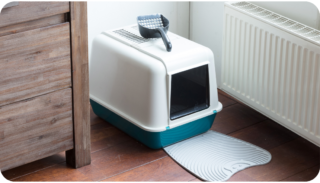
Whether you’ve recently adopted a new kitten or adult cat, litter box issues can be frustrating for both you and your feline friend. But they don’t have to be! Here are some helpful steps on how to litter box train your new cat or kitten.
1. Location, Location, Location
Training your cat to use the litter box can be simple, and it should start with looking at things from their perspective; when you go to a restaurant or gas station, a common question you might ask is, “Where’s the bathroom?” Even though your cat can’t speak human, they may wonder the same thing.
Placing the litter box in the basement or rooms that are far from main areas of the house may deter your cat from making the journey. Try to find a location that’s comfortable for you, but also conveniently accessible for your cat. Once you’ve chosen the perfect spot, familiarize your cat with its location so they’ll be sure to remember when go-time arrives.

Moving your cat’s food away from the litter box is important, too! Imagine if your bathroom was next to your kitchen table — or when the restaurant host sits you right next to the bathroom … enough said? And if you have a smaller living space, no problem! Just be sure to allow adequate space between their food and litter box.

If you’ve just adopted (or have recently moved to a new home), set yourself up for success by keeping your cat confined to an area as they get used to their surroundings. This will restrict roaming and aid in litter box training. Place your cat in the litter box throughout the day to help them understand the purpose of the box. For kittens, move their front paws back and forth in a scratching motion to give them a little extra help. It’s amazing how kittens as young as 3 to 4 weeks old seem to instinctively understand this motion.
After making a few deposits into the litter box, your feline family member will begin to recognize their scent and should continue using it correctly. Once they’ve proven litter box success and have adjusted to their new environment, you can give them more freedom to roam. Remember: if you choose to relocate the litter box to a more convenient location, it’s kitty-courtesy to show them where it’s been relocated.

2. Consider Size
For a young kitten, providing a litter box that is too big might cause them to use it as a playground rather than a place to do their business. Conversely, if you have a larger cat, providing a small litter box can cause overflow or accidents outside the box. Note that these outside-the-box accidents may be a social statement from your cat to let you know something about the box isn’t meeting their standards. It may take a few attempts with different box sizes, but eventually you’ll find the perfect fit.

Some cats prefer a little privacy, and a covered litter box can provide the perfect hideaway for your kitty to bury their unwanted treasures. Other cats are not so modest, so if they seem too hesitant to enter the box, you can always remove the lid.

There are many makes and models of litter boxes on the market today. Self-cleaning and even “hidden” boxes that double as furniture are all the rage. But don’t go overboard with litterbox flair, because it may actually deter your cat from using it. It’s best to keep it simple at first. After all, it’s just a cat’s toilet.
3. Keep it Clean
According to Cats International, “cats have 200 million odor-sensitive cells in their nose, compared to only 5 million for humans.” Just like we turn up our noses at a not-so-clean restroom, cats will do the same with their litter box.
Cleaning frequency will depend on many factors:
- How many cats are in your home
- How often they go
- The size of your space
Some owners prefer to clean the litter box daily, while others find that 3 to 4 times a week is sufficient. Companion Protect® recommends daily scoops to reduce urinary tract infections and other litter box uh-ohs, but it’s always best to chat with your vet.
As humans, many of us prefer to have perfumes or air fresheners in our bathrooms. Litter manufacturers know this and market their products to us rather than our feline friends. Product tag lines such as “fresh scent” or “made with Febreze/Gain/Glade” may appeal to our own olfactory senses but can be a significant deterrent for your cat. If these overpowering scents create sensory overload for your kitty, they’ll be less likely to use the litterbox.
Cleaning the litter box on a regular basis should be enough to keep odors down, provide a fresh place for your cat to potty, and avoid the need for overpowering scents that may actually repel them from using the box. We suggest picking a specific time of day to clean the box regularly (e.g., first thing each morning), that way it’s never forgotten.


4. Ensure There Are Enough Boxes to Go Around
If there are multiple cats in the home, it’s a good idea to have more than one litter box. Some kitties don’t like to share their intimate space with others. Additionally, multiple boxes can help keep odors to a minimum, and if you have a larger home, it allows your cats easy access when they need to go.
Renowned cat expert, Jackson Galaxy, suggests the “one box per cat + 1” rule of thumb. This means if you have one cat, you should have two boxes available in different locations. If you have two cats, you should have three boxes, and so on. Keep the size of your space in mind when applying this rule. For example, if you have one cat in a one-bedroom apartment, one box may be completely sufficient.
Small, one-level home or apartment:
![]() = 1 box
= 1 box
![]()
![]() = 2 boxes
= 2 boxes
![]()
![]()
![]() = 3 boxes
= 3 boxes
![]()
![]()
![]()
![]() = 4 boxes
= 4 boxes
Large (or two+ level) home:
![]() = 2 boxes
= 2 boxes
![]()
![]() = 3 boxes
= 3 boxes
![]()
![]()
![]() = 4 boxes
= 4 boxes
![]()
![]()
![]()
![]() = 5 boxes
= 5 boxes

5. Patience and Understanding Go a Long Way
According to Adopt A Pet, litter box issues are one of the most common reasons that cats are surrendered or returned to shelters. However, a little research and patience can go a long way to create a harmonious bathroom experience for you and your cat(s). While it would be easier if our feline friends could talk, taking time to observe your cat’s bathroom behavior can open a window of understanding and allow the appropriate adjustments to be made.
6. When in Doubt, Consult Your Veterinarian
If you notice something in the litter box that just doesn’t look right, contact your veterinarian as soon as possible. Additionally, if litter box issues arise and these tips don’t seem to do the trick, be sure to consult with your veterinarian.
Companion Protect can add an extra layer of protection should your new or current kitty’s litter box concerns be due to a medical or behavioral condition. From medical diagnostics to prescription medication, Companion Protect can be a critical partner in providing coverage to keep your kitty healthy as well as get your furry friend back in the box if issues do arise!
 NORA GILMORE
NORA GILMORE
Certified Claims Adjuster
Nora has spent her career in both the human and animal medical world including veterinary clinics and shelters. She is passionate about volunteering, especially for animal adoption events, spay/neuter programs, as well as fostering cats and kittens for local rescues. While she doesn’t have as strong a passion for cooking, she does enjoy a delicious plate of tacos and guacamole.
Sources: Adopt-A-Pet, Jackson Galaxy, Cats International

